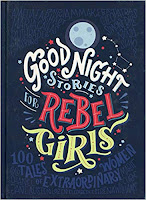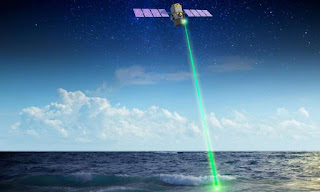Tales of Gender Bias in Science
Fairy tales
 Have you come across a book called “Good night stories for rebel girls"? It started as a crowd-funded initiative of two Italian writers , Elena Favilli and Francesca Cavalli, and it is now an acclaimed
success of public and critics. I bought a copy
for my children (the 12-year old daughter that you have already met and
my 10-year old son, yes a book on rebel girls is highly recommended for
young boys). The book is an anthology of biographies of amazing women
narrated in the style of a fairy tale. “Once
upon a time there was a girl named Ada who loved machines.” is the beginning of the tale of
mathematician and computer scientist Ada Lovelace. And so on through the
lives of well-known and less known remarkable women. I loved the book
from day one. At the beginning of my journey into
motherhood, I used to read the traditional fairy tales to my children
but I would always alter the endings. For example, this was Cinderella’s
alternative ending: “Realising that she is the beautiful stranger that
he has met and danced with at the royal ball,
Prince Charming asks her to marry him. Cinderella replies that she
would be very happy to, but first she needs to go to university and
study veterinary (she talks to animals so I guessed that was her
passion). After she has completed her studies, she opens
a successful practice and marries the prince. And they live happily
ever after or until that works for them.” Similarly Snow White had a
brilliant career in singing, Aurora (Sleeping Beauty) in psychology and
hypnotherapy, and Rapunzel in hair styling (that
was the most obvious).
Have you come across a book called “Good night stories for rebel girls"? It started as a crowd-funded initiative of two Italian writers , Elena Favilli and Francesca Cavalli, and it is now an acclaimed
success of public and critics. I bought a copy
for my children (the 12-year old daughter that you have already met and
my 10-year old son, yes a book on rebel girls is highly recommended for
young boys). The book is an anthology of biographies of amazing women
narrated in the style of a fairy tale. “Once
upon a time there was a girl named Ada who loved machines.” is the beginning of the tale of
mathematician and computer scientist Ada Lovelace. And so on through the
lives of well-known and less known remarkable women. I loved the book
from day one. At the beginning of my journey into
motherhood, I used to read the traditional fairy tales to my children
but I would always alter the endings. For example, this was Cinderella’s
alternative ending: “Realising that she is the beautiful stranger that
he has met and danced with at the royal ball,
Prince Charming asks her to marry him. Cinderella replies that she
would be very happy to, but first she needs to go to university and
study veterinary (she talks to animals so I guessed that was her
passion). After she has completed her studies, she opens
a successful practice and marries the prince. And they live happily
ever after or until that works for them.” Similarly Snow White had a
brilliant career in singing, Aurora (Sleeping Beauty) in psychology and
hypnotherapy, and Rapunzel in hair styling (that
was the most obvious).
 I got away with this until my children learned how to read and then
they looked at me and said: “This is not what it really says, is it? You are
making it up”. Clever kids. You can imagine my happiness when I found a
book which not only had my take on traditional
fairy tales (that, incidentally, are full of gender stereotypes) but used
that very genre to tell the real life stories of amazing women.
I got away with this until my children learned how to read and then
they looked at me and said: “This is not what it really says, is it? You are
making it up”. Clever kids. You can imagine my happiness when I found a
book which not only had my take on traditional
fairy tales (that, incidentally, are full of gender stereotypes) but used
that very genre to tell the real life stories of amazing women.
My personal experience
How is that relevant for the experience of gender bias for women in
science? I believe there are parallels. Some women scientists sadly do experience open discrimination and harassement (which by the way are illegal). However, some women would say that have a “feeling” that things are not right or only
have seemingly small episodes to recount. I’ll give an example
from my personal experience. A few years back when I had recently joined
ECMWF, i.e. I was young, I was invited at
a party to celebrate the retirement of an esteemed colleague. The party
was to be held at a house in the countryside which belonged to another
esteemed colleague. I showed up at the door with other young female colleagues,
slightly overdressed, but with good intentions.
One of the guests opened the door and stated: “Oh, you must be the
neighbours!”. To which we politely explained that no, we were colleagues
of the retiree and worked at ECMWF. Slightly embarrassed the person who
had made the remark let us in. Later on, I sat
next to a male colleague. Across the table, another male guest looked
at us and congenially said to me: “ You must be the wife”, nodding to
the colleague next to me. I politely explained again that no, I was a
colleague of the retiree and worked at ECMWF. That
was all for that evening. I had other similar episodes during my
experience as a woman in science.
 |
| An artist rendering shows a laser beam from a spaceborne LIDAR instrument.
a laser beam from a
satellite-mounted LIDAR instrument probing the plankton-rich waters of
Earth's northern and southern oceans. Credit: Tim Marvel, NASA
Read more at: https://phys.org/news/2016-12-space-based-lidar-plankton.html#jCp
shows a laser beam from
a satellite-mounted LIDAR instrument probing the plankton-rich waters
of Earth's northern and southern oceans. Credit: Tim Marvel, NASA
Read more at: https://phys.org/news/2016-12-space-based-lidar-plankton.html#jCp
shows a laser beam from
a satellite-mounted LIDAR instrument probing the plankton-rich waters
of Earth's northern and southern oceans. Credit: Tim Marvel, NASA
Read more at: https://phys.org/news/2016-12-space-based-lidar-plankton.html#jCp
shows a laser beam from
a satellite-mounted LIDAR instrument probing the plankton-rich waters
of Earth's northern and southern oceans. Credit: Tim Marvel, NASA
Credits: Tim Marvel, NASA.Read more at: https://phys.org/news/2016-12-space-based-lidar-plankton.html#jCp
shows a laser beam from
a satellite-mounted LIDAR instrument probing the plankton-rich waters
of Earth's northern and southern oceans. Credit: Tim Marvel, NASA
Read more at: https://phys.org/news/2016-12-space-based-lidar-plankton.html#jCp |
Another notable one happened to me at a scientific meeting at which
I had been invited as a keynote speaker. After my talk on aerosol lidar assimilation, one male colleague approached me at the
coffee break. We started talking about my
presentation and he said how much he had enjoyed it, and made several nice
remarks. At one point though, he said: “To be honest, I don’t really
know anything about lidars other that they work at the frequency of the
colour green. Green, like your eyes.” I was speechless.
I stopped talking to him and just walked away. I am fine with being
‘chatted up’, that was not the problem, but the fact that it was done in
such a casual way right after I had given a keynote scientific talk
really baffled me.
From the particular to the archetypal
At this point, you may
object that these are just anecdotal and personal experiences which we
cannot generalise. Maybe, but as fairy tales were based on stories that
were fabricated yet had some cultural references
to the time and society that had produced them, so my experience is
possibly not isolated.
It would be interesting to collect more that one story and
understand how may girls have been told that they could not do something
(for example study math) because they were girls and their brain were
wired differently; or how many women were not taken
seriously because the way they looked (see my blog entry on Beauty and Science); or how many women have been precluded from public offices and
high level jobs because they have been told they are too emotional or too hormonal or too old or too young or too aggressive
or too weak etc.
Only then, when we have a full picture of the “fairy tale”, we can really change the ending.
Very nice post Angela! And unfortunately, quite true for many women. Just to share my experience, recently my husband met a new client and when they were talking about their families, my husband mentioned that I worked in ECMWF. Then, the other guy said: oh! Nice place! Is she the receptionist or does she works in the restaurant? I am not sure if they were referred to a man in the same way (I mean, working in a restaurant or as a receptionist is perfectly fine! But if you mention ECMWF, probably is the last profession that you are thinking on...). We can live with this, for sure, but as you says, how we educate our children can make the difference in the future.
ReplyDelete